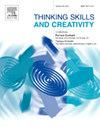基于设计的学习中适应者和创新者的失败容忍度与创新倾向
IF 4.5
2区 教育学
Q1 Social Sciences
引用次数: 0
摘要
创造力和创新是驾驭当今多变、不确定、复杂和模棱两可的世界的基本技能。本研究考察了新加坡一所大学设计基础学习(DBL)课程中学生的创新倾向和失败容忍度。基于DBL培养这两种特质和容错能力支撑创新能力的前提,我们在课程开始和结束时对240名学生进行了Kirton适应创新量表(KAI)和学校容错能力量表(SFT)。数据收集后,根据学生的总体KAI分数,将他们分为适应者和创新者。结果表明,适配器和创新者在故障容忍度上存在差异。创新者比适应者有更高的情感(情绪弹性),但更低的行动(结构化的问题解决反应)。虽然DBL后总体KAI得分保持不变,但更深入的分析揭示了变化:适应者的创新倾向增加,而创新者的创新倾向减少。此外,学生在DBL课程中变得更加容错,特别是在首选难度方面。这些结果表明,DBL促进了这两种特征的发展,而失败容忍本身并不能完全解释创新。通过理清失败容忍的维度并将其与创新倾向联系起来,本研究为教育环境中现有的创新发展模型增加了粒度。本文章由计算机程序翻译,如有差异,请以英文原文为准。
Adaptors’ and innovators’ failure tolerance and innovative tendencies in design-based learning
Creativity and innovation are essential skills for navigating today's volatile, uncertain, complex, and ambiguous world. This study examines students’ Innovative Tendencies and Failure Tolerance in a Design-Based Learning (DBL) course at a Singaporean university. Grounded in the premise that DBL fosters both traits and that Failure Tolerance underpins Innovativeness, we administered the Kirton Adaption-Innovation Inventory (KAI) and the School Failure Tolerance (SFT) scale to 240 students at the start and end of the course. Post-data collection, students were categorized as Adaptors and Innovators based on their overall KAI score. Results indicate that Adaptors and Innovators differed in their Failure Tolerance. Innovators have higher Affect (emotional resilience) but lower Action (structured problem-solving response) than Adaptors. While overall KAI scores remain unchanged after DBL, deeper analysis revealed a shift: Adaptors’ Innovative Tendencies increased, while Innovators’ Innovative Tendencies decreased. Additionally, students became more Failure-tolerant over the DBL course, particularly in terms of Preferred Difficulty. These results suggest that DBL fosters the development of both traits, and that Failure Tolerance alone does not fully account for Innovativeness. By disentangling dimensions of Failure Tolerance and linking them to Innovative Tendencies, this study adds granularity to existing models of innovation development in educational settings.
求助全文
通过发布文献求助,成功后即可免费获取论文全文。
去求助
来源期刊

Thinking Skills and Creativity
EDUCATION & EDUCATIONAL RESEARCH-
CiteScore
6.40
自引率
16.20%
发文量
172
审稿时长
76 days
期刊介绍:
Thinking Skills and Creativity is a new journal providing a peer-reviewed forum for communication and debate for the community of researchers interested in teaching for thinking and creativity. Papers may represent a variety of theoretical perspectives and methodological approaches and may relate to any age level in a diversity of settings: formal and informal, education and work-based.
 求助内容:
求助内容: 应助结果提醒方式:
应助结果提醒方式:


